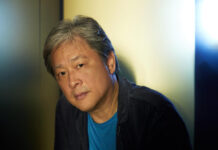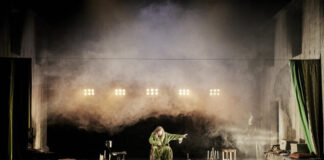Caroline (all the high school students mentioned requested anonymity) stands in front of the microphone placed on the sidewalk of a Strasbourg artery, on this sunny Monday morning in May, and reads in front of around thirty people an extract from the novel by the Russian writer Vasily Grossman Life and Fate (Manhood, 1980), in which a Jewish mother awaits death in the Berdychiv ghetto, Ukraine, liquidated by the Nazis in September 1942. “I’m sure, Vitya , that this letter will reach you, although I am behind the barbed wire of the Jewish ghetto. I will not receive your answer because I will no longer be of this world…”, states in an uncertain voice the Belarusian high school student.
With two comrades from the Russian section of the Lycée des Pontonniers, in Strasbourg, and a Ukrainian student who has just arrived in France, she is taking part in the unveiling ceremony of new Stolpersteine, small golden brass cobblestones sealed in the ground in front of the homes of Jewish victims of the Holocaust. Black skirt, white shirt, white and red manicure – symbol of Belarusian opponents – on one hand, and blue and yellow – the colors of Ukraine – on the other, Dr. Martens shoes with blue and yellow laces too, the look of the young girl tells her story and her questions. The first-grade student, who arrived in France five years ago, is worried about the ongoing repressions in her country and, with her Ukrainian boyfriend, is immersed in the war that is raging in Eastern Europe. So commemorating the victims of the Holocaust sounds obvious today: “If we forget these terrible events, they will repeat themselves. »
Participation in this ceremony is one of those little stones of memory that her teacher, Raïssa Smirnov, tries to sow in the minds of her students. The Lycée International des Pontonniers, among the most upscale in Strasbourg, organizes every year, at the beginning of May – except for the last two years due to the epidemic due to Covid-19 -, “memory days” around the Second World War world. A way to pay tribute to the 36 teachers and students of the establishment who were victims of Nazism. Exhibitions, cross-courses between the different international sections (English, Italian, Russian, Polish, German, etc.), testimonies from descendants of Holocaust victims or artistic workshops punctuate these days.
“Sharing Memories”
Within the Russian section – which Raïssa Smirnov, its head, prefers to describe as “Russian-speaking”, given the diversity of origins of its students -, this initiative takes on particular importance in the light of current events. The war in Ukraine is not only in everyone’s mind, it is also in the daily life of some of the 56 high school students who make up this section. Chechens, Russians, Moldavians, Ukrainians, Armenians or Azeris… The students, the vast majority of whom have scholarships, come from all over the former Soviet area and beyond. While a minority of them were born in France, most arrived there three, five or ten years ago. As a result, some still have family in Ukraine or Russia, others fear an extension of hostilities in their country of origin. For others, finally, the current conflict awakens past traumas.
Combining “the big story and the little story” is the goal of Raymond Levy, who speaks in front of the second class that day. The septuagenarian comes to tell “his ghosts” and, through them, the history of the Jews in 20th century Europe. “Without the successive wars, my parents would not have met”, he quips, detailing, on the one hand, the trajectory of his paternal grandparents who fled Alsace for Limousin in the free zone during the Second World War and, on the other hand, his maternal grandparents, one born in Ukraine and the other in Russia. Raymond Levy lost track of this second grandfather in 1933. He would like to launch a longer-term project with these Russian-speaking students to be able to consult the archives and fill in the gaps in his history.
A discussion begins at the break between the septuagenarian and Romain. Born in France, of Russian and Ukrainian origin, he also tries to understand the great story through the course of his family. His grandfather is still in Russia, but he cannot visit him at the moment. He clings to the family trees provided to him. A recent concern: “I was unaware of Russian history until a few years ago. It’s like all these past and present conflicts are part of who I am today,” he said.
This work on memory thus hits the family story of students marked by exile. After the intervention of another descendant of a family of deportees, Marcel, a final year student of Moldavian origin, makes the link between yesterday and today. “Sometimes people don’t want to ask questions,” he laments. He followed his second class in Moldova before arriving in France and realizes the differences in historical approaches between the two countries. “It’s like we don’t want to see the 20th century in my home country,” he says. The young man deepened his knowledge of Stalin, discovered the figures of repression and stimulated a dialogue with his parents “who were not properly informed” on the subject. But he also learned about the existence of the Armenian genocide during these courses and exchanges with students from this country. For him, no doubt, it is necessary to “share memories”.
This is what Kheda and Chamil are about to do. Chechens, they prepare a presentation on the deportation of their compatriots by the Soviets, in 1944, and will present it in the afternoon in Russian in front of other high school students. “Most people don’t know about this event,” Kheda pleads. “This work triggers in some the desire to know more about the history of their family, but also that of their people”, notes Raïssa Smirnov, who left Russia in the 1990s and became French in 2002. .
Tensions in recent months
These days also resonate with current events. The Ukrainian conflict is present, if not in everyone’s mind, on every wall. Texts by great Ukrainian authors – Gogol, Shevchenko, Lessia Oukrainka – were pinned, a few days after the start of the conflict, on the central staircase of the school. In the classroom reserved for the section are pasted poems in Ukrainian and French by a student of the section, Samira, which she wrote at the end of February. “My Ukraine is on fire/ Circle of black crows in the sky/ Nightingales flew away silent/ Bullets fly past them/ It withdraws,” read the posters. “What is happening today must also be remembered,” says the high school student.
Eight Ukrainian students have arrived at the school since the beginning of the conflict. If they are happy to discuss with Russian-speaking students, they have not been integrated into the section for the moment, for lack of sufficient French, and go through an “integration and orientation module” specific to the establishment. .
Among the Russian-speaking pupils, some speak spontaneously of the Ukrainian conflict, others do not want to mention it any more so as not to resurface tensions which have been expressed in recent months. The Russian teacher observes: “The comments made by the parents diverge with those of the national education system. The families don’t often speak French and watch Russian television “where we don’t talk about war but about “special operation”, remarks Ms. Smirnov. A few students say it half-heartedly. Sofia thus shows herself to be reserved and wants to be “neutral” because, for her, “information is everywhere subjective”.
The teacher assures “let the questions come if there are any”: “current events can bring up past traumas. We must also take into account their suffering and try, despite everything, to give them the keys to reflection”. Keys to reflection that Ms. Smirnov wishes to launch with these days of memory. The teacher sees it as a mission: “Most of these young people will stay in France, and even become French citizens. These days of memory are part of their citizenship training, of the transmission of the values of the Republic that we must instill in them. »














